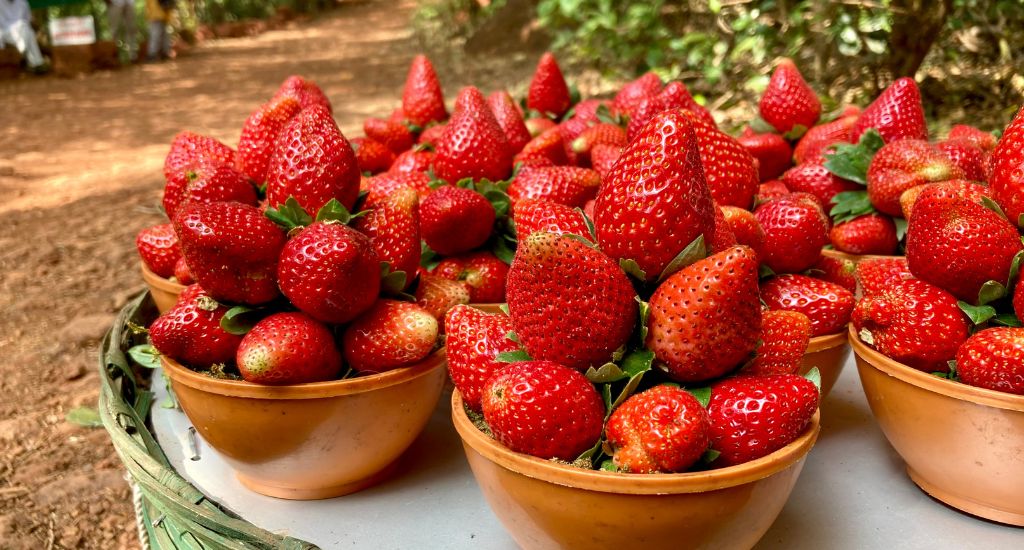
Sweet strawberry surprise serenades Jharkhand fields
Farmers of Jonha panchayat in Ranchi district in Jharkhand are adopting newer exotic crops like strawberry. It is helping them become economically prosperous while enjoying direct market access.

Farmers of Jonha panchayat in Ranchi district in Jharkhand are adopting newer exotic crops like strawberry. It is helping them become economically prosperous while enjoying direct market access.
Strawberries are a popular favourite, whether you have them whole or blend in icecreams and shakes, or use them in baking. But if you think the little berries are solely an urban phenomenon, things are changing slowly and surely!
Indian farmers are discovering the economic benefits of cultivating strawberries and other high-yield exotic crops. One such example is in the rural economic zone (REZ) of Jonha panchayat area, which falls under Angara block in Ranchi district of Jharkhand.

There has been a slow and steady transformation in the farmers’ fortunes, starting with the adoption of the organic way of farming in the last decade. Says Bapi Gorai, Manager, Farm Prosperity at Transform Rural India (TRI), “We helped them switch to jaivik dawa (organic pesticides). Meanwhile, bio-resource centres (BRC) provide farmers with access to organic pesticides, supplementary nutrients, and seedlings. We are regularly in touch with them to lend our support.”
Also read: Gasoo – the strawberry bowl of Kashmir
The region is known for its uneven and scattered land. Thanks to recent interventions, a farmer can expect to earn around Rs 6,000 per week from 15 kg of strawberries, amounting to Rs 50,000 in two months from just 10 decimals of land (approximately 404.6 sq m).
Currently, there are 20 farmers engaged in cultivating strawberries on six decimals of land each. Overall, more than 600 farmers are engaged in cultivating crops beyond the traditional seasonal options like paddy. While the strawberries are mostly sold in the market, some have started enjoying them as well, although it’s a new habit.
Other exotic vegetables, like zucchini and broccoli, are also becoming a part of farmers’ diets. While broccoli is regarded as similar to cauliflower, zucchini is used as a potato substitute.

As farmers look forward to higher incomes, the challenge of crop security has also been addressed through net houses that keep away monkeys. Besides, the focus on enabling direct market access is also helping farmers grow their incomes while increasing the demand for their produce.
Poonam Devi, a 28-year-old woman from Jaratoli village, Jonha panchayat, has transformed her life through sustainable farming. Her family, which includes her husband and mother-in-law, survived on traditional crops like paddy, millets and black gram, with negligible income. The turning point came when Poonam joined the Jyoti Mahila Samooh (a women’s self-help group) in 2017.
In the midst of all this, her husband Birsa Munda migrated to Gujarat in search of better work opportunities, but returned disillusioned in a year, determined to improve their livelihood in the village itself.
Their breakthrough came when they learned about the irrigation well scheme under MGNREGA from Rajesh Kumar Mahto of TRIF. They applied through the Gram Sabha, and in 2022-23, received approval for an irrigation well. This marked the beginning of their agricultural transformation.
With support from TRI, in July 2024, Poonam adopted a protected farming model and initially cultivated spinach, coriander, and radish. This yielded a profit of Rs 7,000, motivating her to expand further. Encouraged by this success, she and her husband decided to take a bold step—experimenting with strawberry cultivation in November 2024.
The strawberries had excellent colour, shine, and sweetness, making them highly marketable.

Also read: Bihar farmers taste success with sweet strawberries
Using organic inputs, mulching, and drip irrigation, Poonam successfully grew strawberries of the Winter Down variety. The strawberries had excellent colour, shine, and sweetness, making them highly marketable. To her delight, she sold Rs 32,000 worth of strawberries initially, and seeing the demand, she now plans to scale up production next year.
Poonam sells her produce directly from her home and in the local Jonha market. The adoption of organic farming practices has also helped her gain customer trust, ensuring quicker sales and higher demand. She plans to expand her strawberry cultivation in the next season. She also intends to increase her plantation area, as strawberries not only fetch a good price but also have strong market demand.
The Jonha village has a population of around 10,028 people across 2106 households. The potential household income growth, from a Rural Economic Zone (REZ) outlook, is projected to increase up to Rs 1.5 lakh per household.
Community engagement is the catalyst, with residents actively contributing as change agents. The scope includes economic engagements across the villages of Dahua, Lepsar, Dokad, Jonha, Jidu, and Jaratoli, which are in proximity to Jonha bazaar.
The engagement also aims for 100% Scheme Saturation, ensuring the effective implementation of government schemes, workforce migration to secondary and tertiary sector, increase in accessibility of services for the community while year-round agriculture is being strengthened to support farming sustainability.
The vision includes institutional strengthening by conducting FGDs (Focused Group Discussions) and PRA (Participatory Rural Appraisal) to assess income trends and socio-economic improvements.

Capital and technology integration plays a significant role in evaluating resource allocation to enhance financial and technological access.
Infrastructure expansion is another critical aspect, with key development areas identified for roads, markets, digital infrastructure, and utilities. It aims to work with localities to increase their coordination in decision-making for panchayats, based on data based evidence through collaboration with the public and private sector.
Jonha is abundant in forest, tourism and bio diversity, which makes it ideal for such intervention.
Also read: Strawberry cultivation brings sweet success to farmers
The lead photo on top shows delicious strawberries, which were earlier considered an urban phenomenon, but are now becoming a rural reality, thanks to organic farming and innovative ideas. (Photo courtesy Shutterstock)